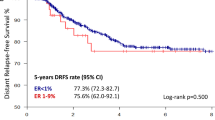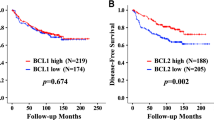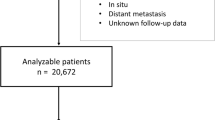Abstract
In 215 patients with operable breast cancer (T1-T3, N0-1, M0) and no other or previous cancer, presenting to a single breast unit, sufficient tumour was available for the prospective determination of four putative biochemical markers of prognosis: oestrogen receptor (ER) activity, cathepsin D (cath D), epidermal growth factor receptor (EGFR) activity and cyclic AMP-binding proteins (c-AMP-b). There were significant inter-relationships between ER and EGFR (r = -0.26), c-AMP-b and cath D (r = +0.32) and ER and c-AMP-b (r = +0.14). After follow-up (median 36.2 months), a total of 55 recurrences (18 locoregional only) and 35 deaths were recorded. By univariate analysis, up to 10 of 18 biochemical, clinical and histopathological variables of potential prognostic value were significantly related to disease-free interval or death, but by multivariate analysis only oestrogen receptor concentration and node status contributed significantly to risk of both distant recurrence/death; in addition, tumour size made a small contribution to the risk for a distant recurrence only. Only two parameters, tumour grade and ER concentration, were significantly related to risk of locoregional recurrence by univariate analysis, but by multivariate analysis, only tumour grade was important. It is concluded that tumour ER concentration, axillary nodal status and tumour grade remain as the most important prognostic factors in the early years after presentation of operable breast cancer, with a minor influence of tumour size. At this time, the prognostic significance of quantitative measurements of ER concentration, carefully controlled for the quality of both assay and tumour specimen, is probably greater than is generally appreciated. We have yet to identify other factors, which add significantly to the short-term prognostic value of these key features.
This is a preview of subscription content, access via your institution
Access options
Subscribe to this journal
Receive 24 print issues and online access
$259.00 per year
only $10.79 per issue
Buy this article
- Purchase on Springer Link
- Instant access to full article PDF
Prices may be subject to local taxes which are calculated during checkout
Similar content being viewed by others
Author information
Authors and Affiliations
Rights and permissions
About this article
Cite this article
Hawkins, R., Tesdale, A., Killen, M. et al. Prospective evaluation of prognostic factors in operable breast cancer. Br J Cancer 74, 1469–1478 (1996). https://doi.org/10.1038/bjc.1996.567
Issue Date:
DOI: https://doi.org/10.1038/bjc.1996.567
This article is cited by
-
Human dyskerin binds to cytoplasmic H/ACA-box-containing transcripts affecting nuclear hormone receptor dependence
Genome Biology (2022)
-
The prognostic significance of a combined determination of cathepsin D and estrogen receptors in breast carcinomas with positive axillary lymph nodes
Chinese Journal of Clinical Oncology (2006)
-
Outcome after extended follow-up in a prospective study of operable breast cancer: key factors and a prognostic index
British Journal of Cancer (2002)



